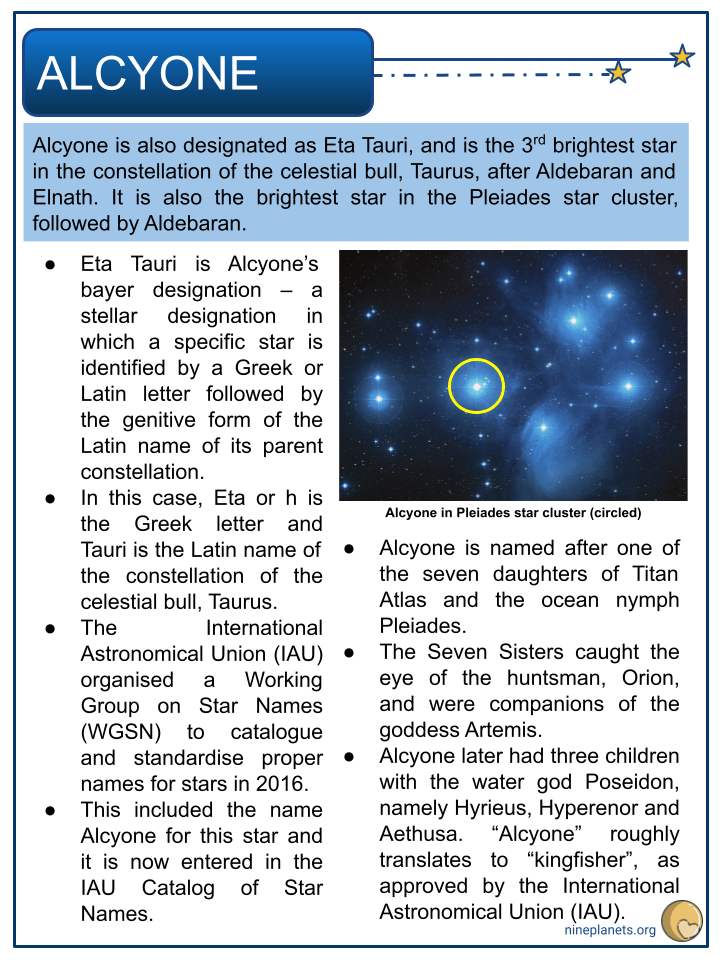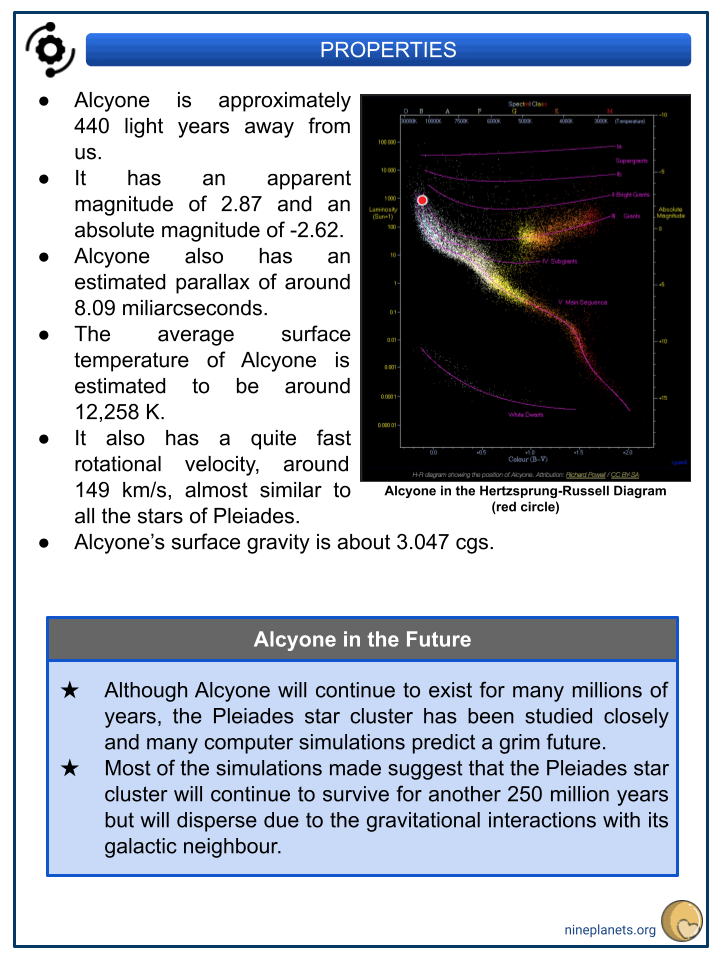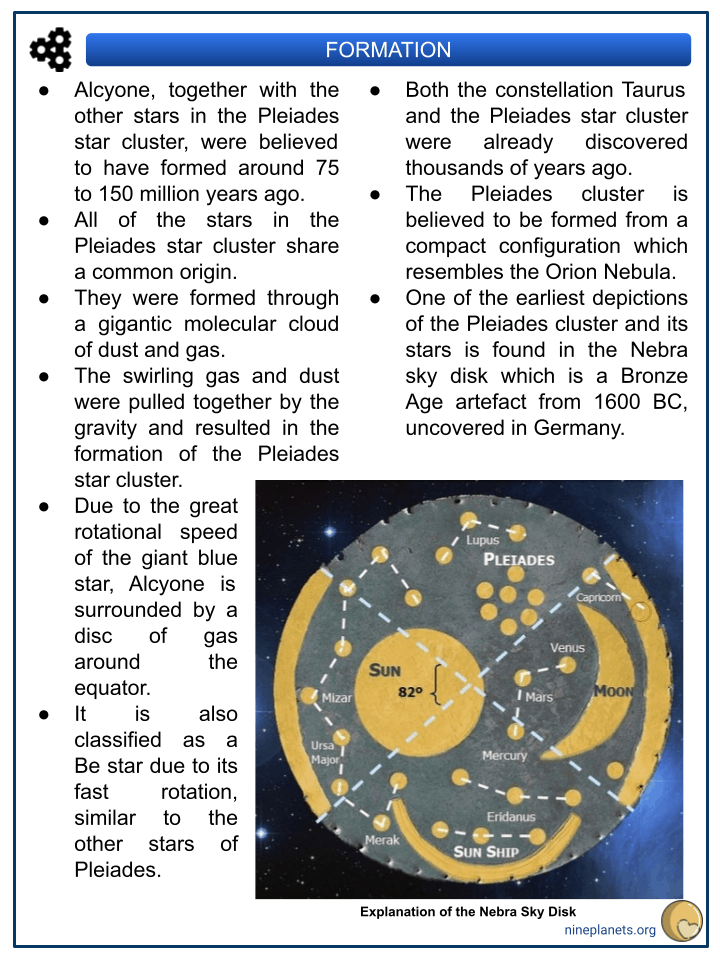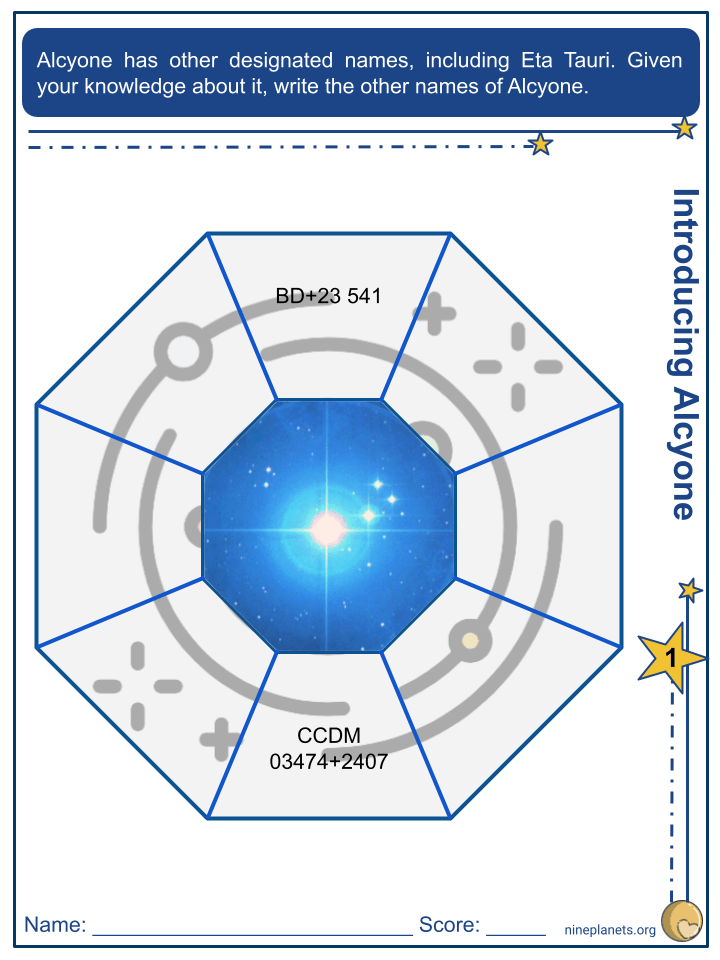Download Alcyone Worksheets
Click the button below to get instant access to these premium worksheets for use in the classroom or at a home.
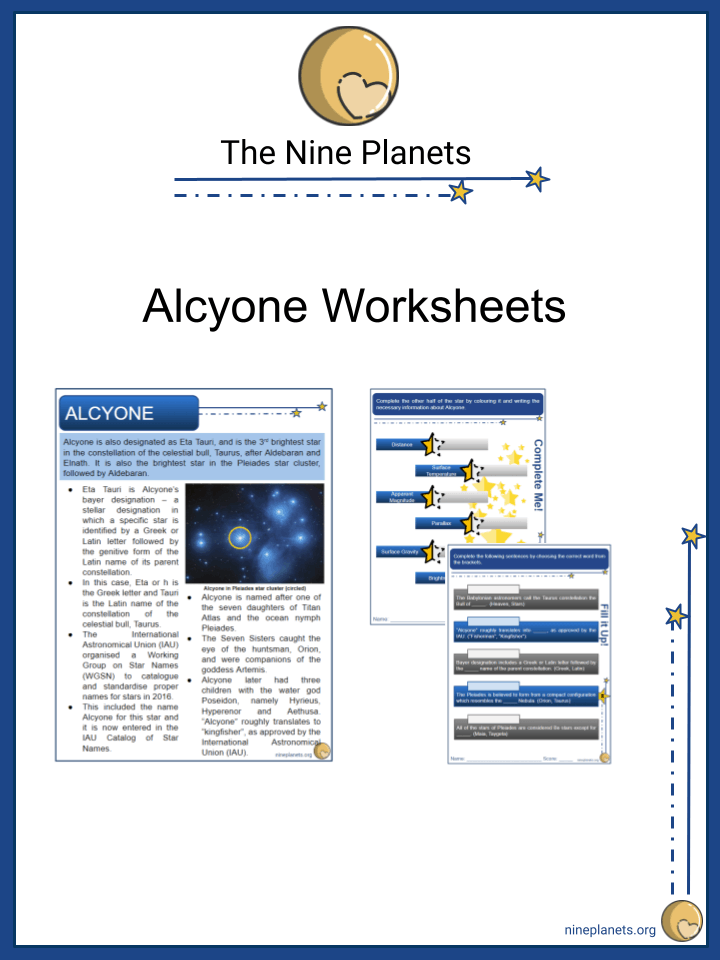
This worksheet can be edited by Premium members using the free Google Slides online software. Click the Edit button above to get started.
Download free sample
Not ready to purchase a subscription yet? Click here to download a FREE sample of this worksheet pack.
Resource Examples
Click any of the example images below to view a larger version.
Key Facts & Information
- Alcyone is also designated as Eta Tauri, and is the 3rd brightest star in the constellation of the celestial bull, Taurus, after Aldebaran and Elnath. It is also the brightest star in the Pleiades star cluster, followed by Aldebaran.
- Eta Tauri is Alcyone’s bayer designation – a stellar designation in which a specific star is identified by a Greek or Latin letter followed by the genitive form of the Latin name of its parent constellation.
- In this case, Eta or h is the Greek letter and Tauri is the Latin name of the constellation of the celestial bull, Taurus.
- The International Astronomical Union (IAU) organised a Working Group on Star Names (WGSN) to catalogue and standardise proper names for stars in 2016.
- This included the name Alcyone for this star and it is now entered in the IAU Catalog of Star Names.
- Alcyone is named after one of the seven daughters of Titan Atlas and the ocean nymph Pleiades.
- The Seven Sisters caught the eye of the huntsman, Orion, and were companions of the goddess Artemis.
- Alcyone later had three children with the water god Poseidon, namely Hyrieus, Hyperenor and Aethusa. “Alcyone” roughly translates to “kingfisher”, as approved by the International Astronomical Union (IAU).
Properties
- Alcyone is approximately 440 light years away from us.
- It has an apparent magnitude of 2.87 and an absolute magnitude of -2.62.
- Alcyone also has an estimated parallax of around 8.09 miliarcseconds.
- The average surface temperature of Alcyone is estimated to be around 12,258 K.
- It also has a quite fast rotational velocity, around 149 km/s, almost similar to all the stars of Pleiades.
- Alcyone’s surface gravity is about 3.047 cgs.
Alcyone in the Future
- Although Alcyone will continue to exist for many millions of years, the Pleiades star cluster has been studied closely and many computer simulations predict a grim future.
- Most of the simulations made suggest that the Pleiades star cluster will continue to survive for another 250 million years but will disperse due to the gravitational interactions with its galactic neighbour.
Formation
- Alcyone, together with the other stars in the Pleiades star cluster, were believed to have formed around 75 to 150 million years ago.
- All of the stars in the Pleiades star cluster share a common origin.
- They were formed through a gigantic molecular cloud of dust and gas.
- The swirling gas and dust were pulled together by the gravity and resulted in the formation of the Pleiades star cluster.
- Due to the great rotational speed of the giant blue star, Alcyone is surrounded by a disc of gas around the equator.
- It is also classified as a Be star due to its fast rotation, similar to the other stars of Pleiades.
- Both the constellation Taurus and the Pleiades star cluster were already discovered thousands of years ago.
- The Pleiades cluster is believed to be formed from a compact configuration which resembles the Orion Nebula.
- One of the earliest depictions of the Pleiades cluster and its stars is found in the Nebra sky disk which is a Bronze Age artefact from 1600 BC, uncovered in Germany.
Stellar System
- Alcyone A is the primary star of the multiple star system Alcyone.
- It is a giant-blue-white star with spectral type B5IIIe, indicating that emission lines are present.
- Alcyone A also has six times the mass of our Sun, ranging from 5.9 to 6.1 solar masses, and solar radii of around 9.3, making it more than 10 times bigger than the Sun.
- it is also 2,030 times brighter than the Sun and produces a lot more energy though most of its output is in the invisible ultraviolet part of the spectrum.
- Alcyone B, also designated as 24 Tauri, on the other hand, is a white main-sequence star with an apparent magnitude of 6.28, and 117” away from Alcyone A.
- It has a very low mass and is less than 1 milliarcsecond away, with a 4-day orbital period.
- Main-sequence stars fuse hydrogen atoms into helium atoms inside their cores.
- Alcyone C, also designated as V647, is a Delta Scuti variable star with a varying brightness ranging from 8.25 to 8.3 magnitude, and a period of 1.13 hours.
- It has around half the mass of Alcyone A and is separated by 0.031 arcsecond, almost similar to the distance of the planet Jupiter to the Sun with an orbital period of 830 days.
- Delta Scuti stars, also known as dwarf cepheids, are a subclass of young pulsating stars used to establish the distances to the Large Magellanic Cloud, globular clusters, open clusters, and the Galactic centres, together with the classical cepheid variables.
- Alcyone D is a white main-sequence star with 9.15 visual magnitude.
- The Washington Double Star Catalog also describes Alcyone D as a double star with two nearly equal components 0.30” away from each other.
Taurus
- The constellation of the celestial bull, Taurus is among the largest in the night’s sky, and is also one of the most prominent of the northern constellations with an area of 797 square degrees.
- It is also home to another open cluster named Hyades, and has many interesting stars such as Aldebaran and Elnath, fascinating deep-sky objects such as the Crab Nebula and Crystal Ball Nebula, merging galaxies NGC 1409 and NGC 1647, the historic supernova remnant Messier 1, the reflection Nebula NGC 1555 or Hind’s Variable Nebula, and a lot more open clusters.
- These celestial objects are best viewed during the month of January.
- In the Old Babylonian Epic of Gilgamesh, the goddess Ishtar sends the bull of Heaven, Taurus, to kill Gilgamesh.
- According to Greek Mythology, Zeus fell in love and wanted to marry Europa, the Phoenician princess.
- He transformed himself into a beautiful white bull with golden horns to abduct the Phoenician princess.
- Zeus got Europa’s attention by mingling with the herd. The princess was then impressed by his spectacular features and went to garland him.
- Zeus carried the Phoenician princess Europa away from Crete as she sat on his back. Zeus and Europa had three sons, namely Minos, Sarpedon and Rhadamanthus.
- Later, Zeus immortalised the bull into the night’s sky.
Pleiades
- The Pleiades star cluster or Messier is one of the open clusters close to the Earth. Even though the open star cluster is very bright, it cannot be seen in the months of May and June since the Sun blocks our view.
- Pleiades can be found in the night’s sky by drawing an imaginary line from the stars of Orion’s belt, namely Alnitak, Alnilam and Mintaka.
- “Pleiades” came from the Ancient Greek and is most likely derived from “plein” meaning “to sail” due to its importance in delimiting the sailing season in the Mediterranean Sea: “the season of navigation began with their heliacal rising”.
- It is also said to be derived from the name of the sisters’ mother, Pleione, thus meaning “daughters of Pleione”.
- All of the stars of Pleiades are Be stars except star Maia.
- The stars of Pleiades were named after the Seven Sisters of Greek mythology, the daughters of Atlas and Pleione – Alcyone (Eta Tauri), Asterope (21 Tauri), Celaeno (16 Tauri), Electra (17 Tauri), Maia (20 Tauri), Merope (23 Tauri) and Taygeta (19 Tauri) – and their parents Atlas (27 Tauri) and Pleione (28 Tauri).
- A lot of famous and ancient texts mention the star cluster Pleiades, such as Homer’s Iliad and Odyssey, Hesiod’s Works and Days, the Bible, the ancient Egyptian Calendar of Lucky and Unlucky Days, and the Japanese Kojiki.
Did You Know?
- Alcyone also has other designated names: η (Eta) Tau, 25 Tau, HR 1165, HD 23630, BD+23 541, FK5 139, HIP 17702, SAO 76199, GC 4541, BDS 1875 and CCDM 03474+2407.
- According to Greek mythology, even the stars in Hyades, another star cluster in the constellation of Taurus, are daughters of Atlas, making them half-sisters of the stars of the Pleiades.
- All of the stars of Pleiades are Be stars except star Maia.
- In Chinese, Alcyone means “the Sixth Star of Hairy Head”, Hairy Head being an asterism including, Alcyone, Electra, Taygeta, Asterope, Maia, Merope and Atlas. This asterism is one of the seven mansions of the White Tiger.
- Taurus is considered one of the oldest constellations since it was recognised during Babylonian times, around 4,000 years ago.
- The brightest star of Taurus, Aldebaran, is the 14th brightest star in the night’s sky, 500 times more luminous than our Sun.
